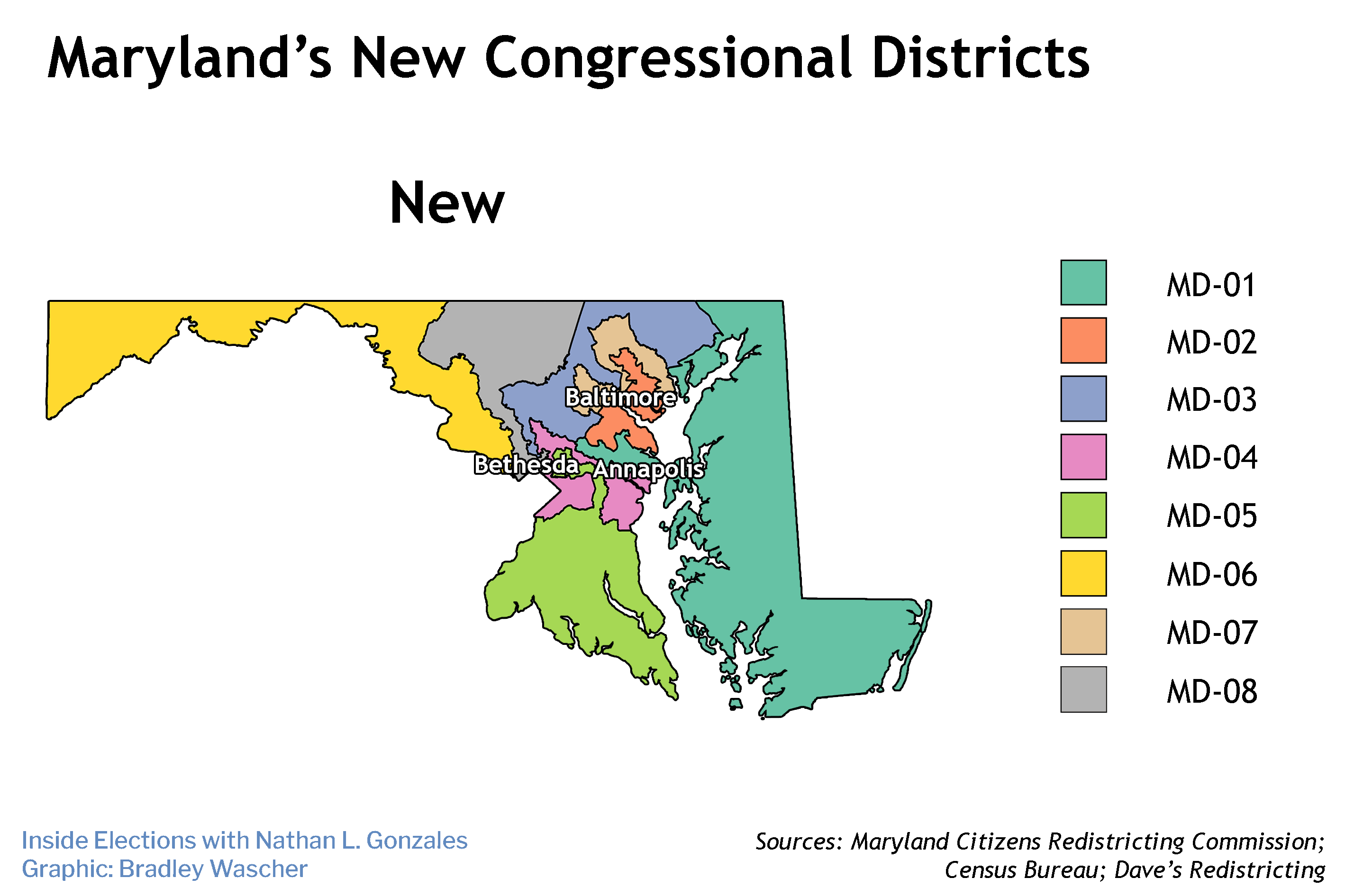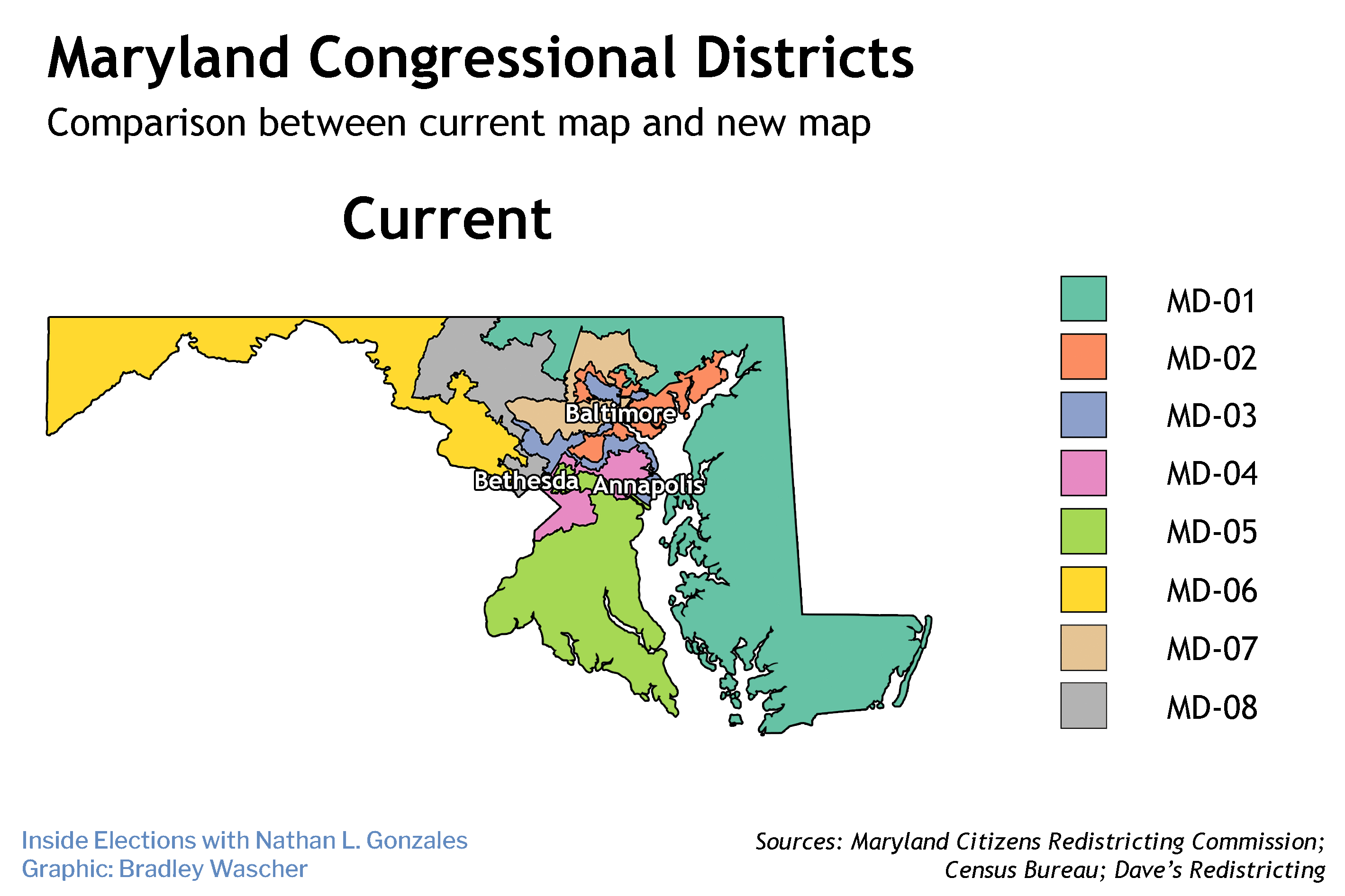Maryland Redistricting: Crossing the Chesapeake
January 21, 2022 · 2:29 PM EST
As one of the few states in which Democrats had full control of redistricting, Maryland was a major focus of national Democrats looking for any advantages heading into a tough midterm election.
But while state legislators in Annapolis moved against the congressional delegation’s lone remaining Republican member, they did not act as aggressively as some Democrats had hoped.
As a result, Maryland is set to see its first competitive congressional general election in nearly a decade, but could still return a delegation of seven Democrats and one Republican, rather than eight Democrats, at a time when every single race matters to Democrats’ five-seat majority.

1st District
Andy Harris is the last Republican standing in the state’s congressional delegation, and the new map means he’ll face his toughest race in over a decade. But while the new map makes the 1st District significantly more competitive, it does not go as far as several other members of the delegation, including Reps. David Trone, Jamie Raskin, and Steny Hoyer had hoped. It still presents a path for Harris to return to Congress.
The new 1st is still anchored by the Eastern Shore but no longer stretches across the state’s northern border with Pennsylvania, and also crosses the Chesapeake Bay to take in a stretch of land just north of Annapolis. Just 60 percent of the new district’s population live in the old iteration. And while the old 1st voted for President Donald Trump by 20 points, 59-39 percent, the new version would have narrowly gone for Biden, 48.9-48.5 percent.
That shift in partisanship means Harris will have a real race for the first time since 2008, when he defeated incumbent Wayne Gilchrest in the GOP primary but narrowly lost to Democrat Frank Kratovil in the general election. Harris defeated Kratovil two years later in a great Republican cycle. In a similar cycle, the new 1st is winnable for Harris in 2022.
On the Democratic side, the frontrunner is former state Del. Heather Mizeur, who ran for governor in 2014 and placed an unexpectedly strong third place. Mizeur has outraised Harris this cycle by nearly two-to-one, but ended September with just $764,000 in the bank compared to his $1.4 million. Retired diplomat Dave Harden is also running as a Democrat but had just $111,000 in the bank on Sept. 30 and is mulling whether to move to the Eastern Shore after his Carroll County home was drawn into another district.
Mizeur is a credible candidate, though she’ll face charges of carpetbagging after moving with her wife from Montgomery County, which she represented in the state legislature, to a farm on the Eastern Shore. Democrats think that Harris has disqualified himself with his stances on coronavirus and the Jan. 6, 2021 insurrection but the partisanship of the district and the national environment still give the GOP an initial edge. Lean Republican.
2nd District
The new 2nd District is a more compact version of its previous iteration, encompassing the northern third of Anne Arundel County, the southern half of Baltimore City, and some of the coastal and suburban areas of Baltimore County.
Democratic Rep. Dutch Ruppersberger will run here — he currently represents about 55 percent of the new district. The district would have voted for Joe Biden, 58-39 percent, so Ruppersberger’s vulnerability would come in a Democratic primary. Progressive challenger Brittany Oliver, an activist from Baltimore County, had $23,000 in the bank on Sept. 30 compared to the congressman’s $1.3 million. The area is rapidly diversifying, which could have created an opening for a younger Black challenger such as Oliver, but Ruppersberger got a boost when his district was drawn to have significantly more white voters than before. Solid Democratic.
3rd District
The 3rd district was the most significantly altered of any in the state, with its old population scattered between six different new districts. While the old, brutally disfigured seat snaked from Annapolis up to Glen Burnie, all the way down to Silver Spring, and then, circuitously, up through Baltimore City, and around to the suburbs in Baltimore County, the new 3rd doesn’t include Annapolis. Instead it is most of Hartford County, a sliver of west Baltimore County with an appendage into Baltimore City, most of Howard County, and a stretch of Montgomery County south to Wheaton.
Current 3rd District Rep. John Sarbanes only represents slightly more than a third of the new district but will run here. The district is much less Democratic than previously, because it absorbed some Republican voters from the old 1st District. But Biden would have carried the seat 61-36 percent, so as long as Sarbanes wins the primary — he has no credible challengers — he’ll be returning to DC. Solid Democratic.
4th District
Incumbent Democrat Anthony Brown is not seeking re-election and is running for state attorney general instead, meaning this solid Democratic seat is up for grabs. The district is still anchored by the inner Prince George’s County suburbs but now also includes some of eastern Montgomery County, and also surrendered some of Anne Arundel County to the new 1st District.
The new seat would have voted for Biden, 83-15 percent, so the winner of the Democratic primary is all but assured a seat in Congress.
There are four Democrats currently in the running, including former Rep. Donna Edwards, who gave up this seat in 2016 to run for Senate (she lost in the primary to Rep. Chris Van Hollen). This is Edwards’ second comeback attempt; she lost in the Democratic primary for Prince George’s county executive in 2018. Glenn Ivey, a former state attorney who lost the 2016 4th District primary to Brown, 42-34 percent, is running, as is state Del. Jazz Lewis, a former Steny Hoyer staffer running with the majority leader’s endorsement. Former state Del. Angela Angel is also in the race. The only public poll so far, sponsored by Ivey, showed Ivey with a substantial lead but did not include Edwards as an option. Solid Democratic.

5th District
House Majority Leader Steny Hoyer’s district was nearly untouched by mapmakers, shedding its portion of Anne Arundel County but seeing few other changes. Hoyer already represents 93 percent of the new district, which Biden would have carried 71-27 percent.
Hoyer faces another primary challenge from activist McKayla Wilkes, who ran against him in 2020 with the backing of groups including Democracy for America and Brand New Congress. Hoyer won, 64-27 percent, with the lowest share of the primary vote of his career.
In 2020, Wilkes raised $444,000 before the primary, but has only pulled in $79,000 so far this cycle, and had just $33,000 in the bank at the end of September compared to Hoyer’s $1.1 million. Because of the proximity to Washington, Hoyer doesn’t have to worry about splitting his time between DC and the district, which has allowed him to avoid the “gone Washington” criticism that has been effective against other longtime incumbents. Solid Democratic.
6th District
Democratic Rep. David Trone’s district is largely unchanged, and still runs from Western Maryland down through Frederick County to the western half of Montgomery County. It would have voted for Biden, 60-38 percent.
Former state Del. Aruna Miller, who placed second to Trone in the 2018 Democratic primary for the 6th District, was planning on running again, but dropped her bid after being tapped by gubernatorial candidate Wes Moore as his running mate.
State Del. Neil Parrott, the 2020 GOP nominee for this seat, is running again. He lost to Trone, 59-39 percent. Parrott had $217,000 in the bank at the end of September. Trone had just $96,000 in his campaign account but won’t lose because of a lack of money. The wine magnate is one of the wealthiest members of Congress and spent $31 million of his own money on races in 2016 and 2018. Solid Democratic.
7th District
Kweisi Mfume, the former president of the NAACP who returned to Congress in 2020 after a two-decade hiatus, was one of the most prominent Democratic voices urging a less aggressive approach to redistricting because it would mean placing more Republican voters into Democratic districts.
In the end, the partisanship of Mfume’s district was relatively unaltered — it would have voted for Biden, 77-21 percent — but its shape shifted notably. The seat shed most of Howard County but still retains its swath of downtown Baltimore City and suburbs east and west of the city.
Mfume has no serious challenger in either the primary or the general election. In 2020, Republican Kimberly Klacik became a viral star on Fox News and as an Republican National Convention primetime speaker and was one of the top House fundraisers in the entire country. She outspent Mfume 10-to-1 and lost, 71-28 percent. She said in late 2020 she would run again. Solid Democratic.
8th District
Jamie Raskin rose to national prominence in 2021 as the lead impeachment manager in the trial of Trump for inciting the Jan. 6 insurrection. He is running again.
The 8th maintains its mushroom shape, with the inner DC suburbs of Montgomery County connected to the more rural Carroll and Frederick Counties. The new seat would have voted for Biden, 65-32 percent, a slight decrease from the old lines because it absorbed some Republican voters from the old 1st District.
Medical logistics specialist/Air Force Veteran Mariela Roca is running as a Republican but had just $4,400 in the bank at the end of the year. Raskin had $1.9 million on Sept. 30. Solid Democratic.